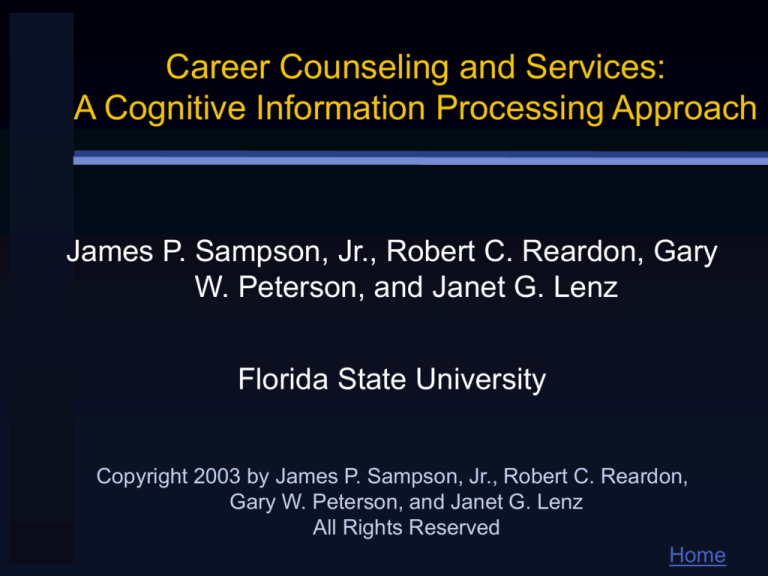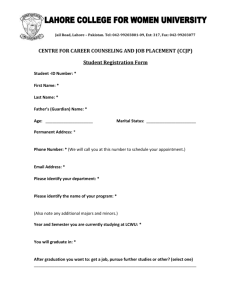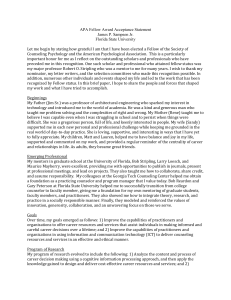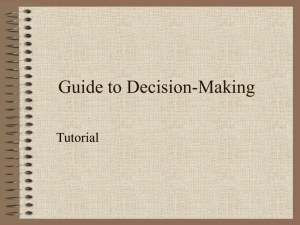
Career Counseling and Services:
A Cognitive Information Processing Approach
James P. Sampson, Jr., Robert C. Reardon, Gary
W. Peterson, and Janet G. Lenz
Florida State University
Copyright 2003 by James P. Sampson, Jr., Robert C. Reardon,
Gary W. Peterson, and Janet G. Lenz
All Rights Reserved
Home
Chapter 12
Developing and Implementing a
Career Services Program: A
Personal Case History
Home
Overview
• Organizational Context
• Establishing a Career Services Program
• Ongoing Program Development
• Personal Reflections
Home
Organizational Context
• Physical setting for a career services
program
• What is required in this setting to help
clients solve career problems and make
decisions?
• Important to provide a center that is
positive, accepting, attractive, neat,
organized, and helpful
Home
Organizational Context
• Goal in designing our career services
program was to:
– respond to basic information needs
– provide the least complex interventions
– draw upon basic staff competencies or
skills
Home
Establishing a
Career Services Program
• In Holland terms, what characteristics do
program developers possess?
• Requires E, I, and S skills and interests
Home
Establishing a
Career Services Program
• Useful guides
– CASVE cycle
– Holland’s RIASEC theory
– ISD Model
Home
Communication
• Gaps in career services in the 60s
– Student demand for career assistance
– Student needs for career information
– Dissatisfaction with academic advising
– Counseling center’s career resources were
minimal
Home
Communication
• Louis Harris survey showing
dissatisfaction with availability of career
and academic information
• Novel approaches to providing career
information
• Separation of career placement, career
counseling, and academic and career
advising
Home
Analysis
• Problem was long standing and
complex; no ready made solutions
existed
• Contacts with key figures in the field,
(e.g., Tiedeman, Holland)
• Contacts with faculty and administrators
Home
Analysis
• College of Education faculty interest in
creating career counseling degree programs
• Similar problem with career information
existed at other institutions
• Successful models using paraprofessional
advisors
• Student career problem-solving needs were
recurring and repetitive
Home
Synthesis
• Exploring potential options
– small career information centers in residence halls
or in student union lobby
– university library
– self-help program that would be client-centered,
matching services to specific client needs
Home
Synthesis
• Exploring potential options (continued)
– multimedia career information delivery system
– include both educational and occupational
information, along with campus and community
referral resources
– staffed by para and pre-professionals
– use instructional systems design (ISD) approach to
develop program components
Home
Valuing
• Considering pros and cons of various
intervention alternatives
• Using ISD to structure program
development process
• Changes role of the counselor/
paraprofessional
Home
Valuing
• Variety of learning activities can be used
• Locate program in student living and
high traffic areas
• Target clients would be lower-division
undergraduates
Home
Valuing
• Create information resources to
complement the work of external staff
• Innovative and reflects creative use of
information in career services
• Personal and professional commitment
to the program development activity
Home
Execution
• Spring 1972, pilot program in residence
hall
• Developed evaluation model to assess
impact of pilot program
• Secured funding
Home
Execution
• Development of 5 instructional modules:
– CCIS Introduction
– Decision Making
– Self Assessment
– Information Resources
– Referral Resources
Home
Execution
• Pilot program launched in January 1973
• Established as an ongoing program called the
Curricular-Career Information Service (CCIS),
Fall 1973
• Second location established in the student union
• CCIS merged with Department of Career
Development Services, 1979
• Comprehensive Career Center created that included
CCIS, career placement, and cooperative education,
1984
Home
Ongoing Program Development
• Existing CCIS career services program
has adapted to changing conditions in
the external environment, e.g.,
– facility relocation
– personnel
– technology
– university structure
Home
Ongoing Program Development
• CASVE problem-solving model
– helped focused ongoing program
development efforts
– can be generalized to other settings
Home
Mission Statement
• Capsule statement of the philosophy of
a social system
• Example of the FSU Career Center’s
mission statement
• Sought to align with the larger mission of
the University
Home
FSU Career Center
Mission Statement
“The mission of the FSU Career Center is to
provide comprehensive career services,
train career service practitioners,
conduct life/career development research,
and disseminate information about life/career
services and issues to the university
community, the nation, and the world”
Home
Systems Perspective
• Career center has unique boundary
spanning role
• Career center involvement in teaching,
research, and service
• Use of CASVE problem-solving model
and instructional systems design help
create and maintain viable career
services
Home
Career Center Continua
•
•
•
•
Involvement in Career Development
Involvement in Experiential Education
Locus of Placement
Locus of Funding
Source: Vernick, S., Garis, J., & Reardon, R. (2000). Integrating service,
teaching, and research in a comprehensive university career center. Article
submitted to the Adult Career Planning & Development Journal.
Home
Involvement in
Career Development
Low
Placement advising
only with career
counseling in the
Counseling Center
or Academic
Advising
High
Comprehensive
career
counseling,
programming &
assessment
Home
Involvement in
Experiential Education
Low
Decentralized
experiential
education
services
High
Mission for coop.
education,
internships & parttime employment
Home
Locus of Placement
De-Centralized
Centralized
Home
Locus of Funding
Self-supported
through client
and employer
fees, fund raising
State/Institutional
appropriated
Home
Comprehensive Career Centers
Career advising & intake
Individual & group
counseling
Assessment & computerassisted guidance
Career information
Career planning classes
for credit
Career education outreach
Experiential education
Career expositions
On-campus recruiting
Job listings & resume
referral services
Home
Theory-Based Services
• John Holland’s theory
– RIASEC/Self-Directed Search
– Personal Career Theory (PCT)
• Cognitive Information Processing
Theory (CIP)
– teach individuals to solve career problems
and make decisions
Home
Fund Raising
• Multiple efforts to raise external funds
• Use external funds to provide resources
for students and community members,
which in turn benefits employers
Home
Fund Raising
• Examples of fund raising activities:
– Placement Partners
– Named Rooms
– Career Advisor Scholarship Program
– Friends of the Career Center
Home
Career Portfolio
• Initial idea began with the University
President
• Program to assist students in
communicating information about their
skills to employers
• Cooperative effort between
Administrative Information Services &
Career Center
Home
Career Portfolio
– Educates students on the importance of
professionally relevant skills
– Provides a system for students
to chronicle their skills
– Web-based portfolio for students to use in
seeking employment and applying to
graduate schools
Home
Career Portfolio Skills
•
•
•
•
•
communication
creativity
critical thinking
leadership
life management
• research/project
development
• social responsibility
• teamwork
• technical/scientific
• optional skill
Home
Web Site Redesign
• Collaborative effort between Career
Center and Tech Center staff
• Use of a needs-based format
• More user friendly design
• Web site becomes integral part of
service delivery (virtual career center)
Home
Personal Reflections
• Clients are willing to take responsibility
for finding and using career information
• ISD model can be used in creating
resources that will help clients achieve
learning objectives
• Clients want information in varied
formats, attractively packaged
Home
Personal Reflections
• Delivery of career information via a
variety of formats
– attractive to administrators
– tangible evidence of service delivery
– facilitates program accountability
• Importance of connecting with the larger
organization
Home
Summary
• Case study of implementing a career service
delivery system
• Illustrates how personal and institutional
commitment, along with CASVE cycle & ISD,
led to creation of career services program
• CASVE paradigm & ISD can be successfully
applied to design, development, and
evaluation of career programs in other
settings
Home
Getting the Most Benefit from Reading
• Identify 3 critical factors that impacted
success of career services programs
• Prepare case for or against proposition and
debate issue
• Identify a setting and prepare hypothetical
case study
• Conduct information interview with person
who has developed a successful program
Home
For Additional Information
www.career.fsu.edu/techcenter/
Thank You
Home








